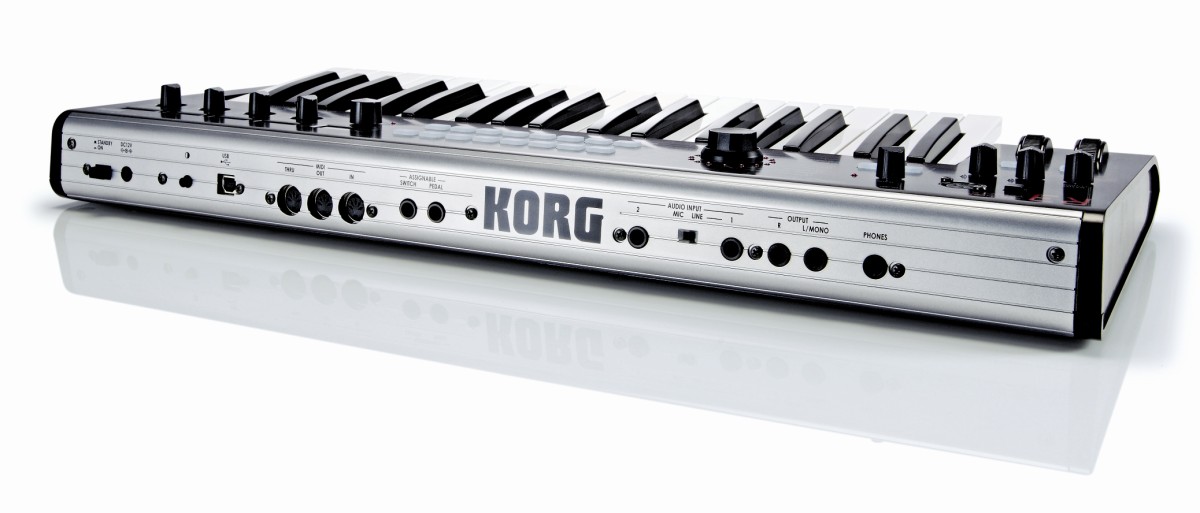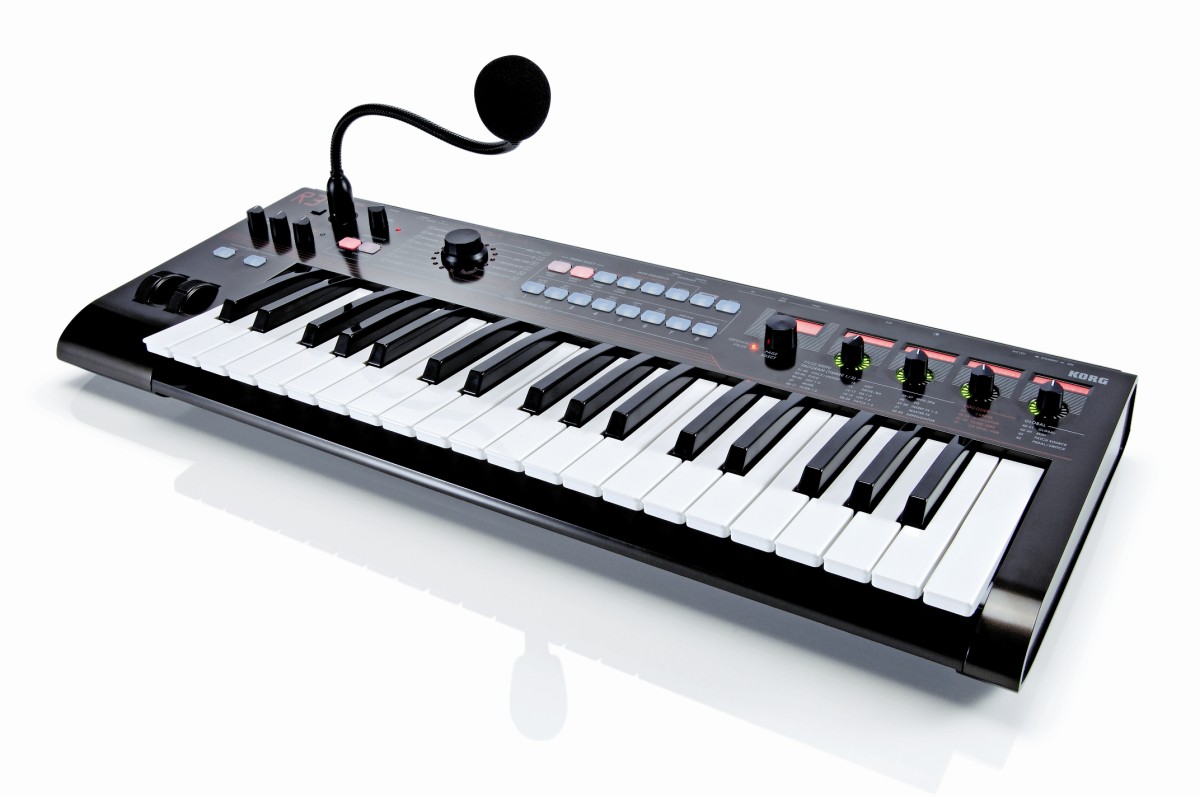MusicRadar Verdict
A superb choice for your first synth, and an excellent synthesizer for live players.
Pros
- +
Loads of synth algorithms and dirty waveshaping. Three Kaoss Pads' worth of effects. Gooseneck microphone.
Cons
- -
Few presets.
MusicRadar's got your back




A few years ago, just when it looked like hardware synths were a dying breed, Korg bucked the trend and scored a major hit with their diminutive MicroKorg. It wasn´t big, it wasn´t too clever, but it was a bundle of instant fun that had just enough going for it to charm its way into everyone´s live set-up.
The R3 is designed on similar principles but ups the game considerably. For starters, the synth engine is identical to the top-line Radias model and that equates to a massive range of sounds from classic to experimental. The three-octave keyboard gives it a bit more room for the players - naturally, they´re full-sized keys and there´s enough space to play solos and hold down chord beds, which is perfect for exploring the power of its 16-band vocoder.
Depending on where your interests lie, the vocoder could be a major reason to get this. Bear in mind that the excellent Radias synth engine is supplying an endless flow of carrier waves, add the convenience of the built-in goose neck microphone and it all makes for a very useful bit of kit for stage, and a sonically excellent choice for the studio.
Another of the Radias engine´s highlights is the way it combines sample recording with the vocoder in the process dubbed ‘Formant Motion´. This allows the user to record (or load via the editor) a sound or voice into the R3, which is used as the modulator waveform for the vocoder. It´s a cute little process, and it's surprising that no-one had thought of it before the Radias. This works much like using a sample as one of the oscillators, so the sample re-starts each time a key is played.
Recording is a simple, one-touch process; up to 7.5 seconds can be captured for each motion and 16 sets of recordings can be stored on the machine. Loading waveforms via the editor is a very viable option and opens up the opportunity to experiment with all kinds of fresh material so it´s not just vocals that get the robot treatment. The editor also comes in handy for sending recordings back to the computer where they can be trimmed, cropped and generally mashed to perfection before transporting them back to the R3 for more mischief.
Patches
Looking at the layout, it´s not exactly crammed with knobs and buttons. The left-hand side has the pitch and modulation wheels, as well as the controls for adjusting the levels for the mic and the audio inputs on the rear. The larger dial in the centre is used for selecting the patch categories, while the back-lit buttons select individual patches. The total number of presets clocks in at 128, which is frankly a bit skimpy for this century but at least the software editor can help.
Want all the hottest music and gear news, reviews, deals, features and more, direct to your inbox? Sign up here.
The five dials on the right are used for most of the programming jobs: one to scroll through the pages and four for editing the associated parameters. Each one has an LCD screen above it - aka a ‘scribble pad´ - which displays its current assignment and an LED halo to show its value. It doesn´t take long to get accustomed to editing in this way, and you may be pleasantly surprised by how fast it is to get around.
Aside from the fixed editing controls, four favourite parameters can be assigned to the dials at the top level, so that when a patch is loaded they´re ready and waiting. This makes a lot of sense - since a sound´s character is all about the interaction of certain parameters, it's hard to imagine creating a patch without using this feature and perhaps this is where having more dials would be much more preferable. If they were placed in the centre of the unit, it would make access a lot easier for left-handed users to tweak, instead of reaching over to the far right every time.
The R3 is two-part multi-timbral. These can be used jointly in one patch or separately where each timbre can be addressed by its own MIDI channel. A timbre uses two oscillators to form the sound, and Korg have loaded it up with a feast of tasty algorithms to feed our gourmet appetites. If you´re not already familiar with what the Radias can do, then check this lot out as it´s much more than a virtual analogue wannabe.
Starting off with the simple pleasures of subtractive synthesis, we get a full complement of essential analogue waveforms. Pulse-width modulation is available on the Square wave, but bizarrely this feature disappears when Unison mode is engaged. What are they saying with this? You can only have a fat detuned square if it´s symmetrical? Following on, the Formant oscillator is an excellent choice for abstract vocal tones, and it can be modulated between three selectable vowel positions for Delay Lama-style singing.
The DWGS mode contains 48 sampled waveforms which cover the digital spectrum. These can come in handy for organ, electric pianos, attack portions on acoustic emulations and so on, but can also be twisted into more deviant activities in the wrong hands. Your next choice is Cross modulation. This dials up some hot and crunchy analogue FM interplay between the two oscillators. Lastly, VPM (Variable Phase Modulation) is Korg´s simple but effective method for achieving basic DX-style overtones. It uses its own sine wave generator and produces credible digital tones including crystal-clear vibes and tight, weighty basses with considerable grunt.
Waveforms
Oscillator Two is a different story. It only offers straight-up analogue-style waveforms, but makes up for it by dishing out ring modulation and sync by the bucket load. Flexibility is the name of the game for the filter section, with two sections and a full choice of routes to follow. Filter one boasts a powerful multimode array of low, high, band and thru. A mix control is used to smoothly blend between the types, so it´s possible to continually sweep between them or blend adjacent types together for interesting effects. The second filter might not have the blend option but it does have the rather special Comb filter - orthodox sound designers tend to use it for plucked string effects. If you unleash its full power and combine it with one of the many excellent wave-shaping FX, it´ll smack you in the face with metallic fury - pure joy for the noise terrorists out there.
The virtual patch chords system does a good job for stock modulations but it´s not overly extensive, mainly because of the limited amount of destinations available. It´s perfectly fine for all the obvious stuff such as routing the LFO to the filter cut-off or the envelope-topitch duties, but it doesn´t want to oblige certain things like FX parameters or waveform selection.
As an alternative to the patch chords, we have the instant fun of the motion sequencer. This feature first appeared with the Electribe series, and scores points for being easy to use with powerful results. It´s as simple as choosing a parameter (for example, the filter cutoff), hitting record and giving the dial a twist. This will record 16 steps of motion and the step length can be defined for shorter or longer sequences as well as many other factors, including glide between the steps and playback direction and looping. It also animates the lighting around the preset selector dial in forward and backward motion when the sequence plays.
The quick and dirty approach to hands-on modulating is balanced with the ability to program the steps in manually and enter specific values for each one. This is great for taking raw ideas and developing them into perfect sequences. If you like effects, you´ll love these. If you're a sucker for the Kaoss Pad, you couldn't be happier with seeing many of your favourites ready to twist up in the R3. From the expected verbs and echoes, to the warped grain shifter, there´s enough to transform any mundane noise or voice into a killer sound. Best of all, they´re BPM-sync´d and can be brought to life with the modulation sequencer too.
Beginners
When you step back and take stock of the whole deal, it´s easy to see who could be attracted to picking up the R3. On one side of the equation, this will put a smile on the face of anyone who thought the MicroKorg was undersized and underpowered. It certainly brings a lot more fire-power to any live set. At the other end, there are those who just can´t justify stumping up the big bucks for the Radias keyboard. If you don´t need the big bro´s multitimbral power, you can now enjoy the glorious sound here.
The R3 is much more than a flexible synth, with the added bonus of the superb integrated vocoder. The street price levels out in line with the Radias, making the R3 a tempting proposition as a first synth or as a healthy fix for your next attack of Gear Acquisition Syndrome.
MusicRadar is the number 1 website for music makers of all kinds, be they guitarists, drummers, keyboard players, djs or producers...
GEAR: We help musicians find the best gear with top-ranking gear round-ups and high- quality, authoritative reviews by a wide team of highly experienced experts.
TIPS: We also provide tuition, from bite-sized tips to advanced work-outs and guidance from recognised musicians and stars.
STARS: We talk to musicians and stars about their creative processes, and the nuts and bolts of their gear and technique. We give fans an insight into the actual craft of music making that no other music website can.
